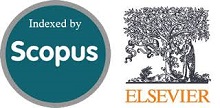Experimental Assessment of Porous Material Anisotropy and its Effect on Gas Permeability
DOI:
https://doi.org/10.28991/cej-0309143Keywords:
Anisotropy, Gas Permeability, Biogas, Raw Gas.Abstract
The results of experimental research upon the assessment of porous material anisotropy and its effect on gas permeability of porous materials with respect to the gas flow. The conducted research applied to natural materials with an anisotropic gap-porous structure and - for comparative purposes - to model materials such as coke, pumice and polyamide agglomerates. The research was conducted with the use of a special test stand that enables measuring the gas permeability with respect to three flow orientations compared with symmetric cubic-shaped samples. The research results show an explicit impact of the flow direction on the permeability of materials porous, which results from their anisotropic internal structures. The anisotropy coefficient and permeability effective coefficient of such materials was determined and an experimental evaluation of the value of this coefficient was conducted with respect to the gas stream and the total pressure drop across the porous deposit. The process of gas permeability was considered in the category of hydrodynamics of gas flow through porous deposits. It is important to broaden the knowledge of gas hydrodynamics assessment in porous media so far unrecognised for the development of a new generation of clean energy sources, especially in the context of biogas or raw gas production.
References
[2] WaŠ‚owski G. „Hydrodynamika przepŠ‚ywu gazu przez zŠ‚oŠ¼e porowate: praca doktorska [Hydrodynamics of gas flow through porous deposits: doctoral thesis]”. Politechnika Opolska, Opole (2015).
[3] Demichowacz-Pigoniowa J. „Obliczenia fizykochemiczne, Termodynamika chemiczna i nauka o fazach, [Physicochemical calculations, Chemical thermodynamics and phases learning]”. WrocŠ‚aw (1975).
[4] Strzelecki T., Kostecki S., Š»ak S. „Modelowanie przepŠ‚ywów przez oŠ›rodki porowate [Modeling flows through porous media]”. DolnoŠ›lÄ…skie Wydawnictwo Edukacyjne, WrocŠ‚aw (2008).
[5] Aksielrud G.A., Altszuler M.A. „Ruch masy w ciaŠ‚ach porowatych [Movement of mass in porous bodies]”. WNT, Warszawa (1987).
[6] Mozhaev A.P. Journal of Engineering Physics and Thermophysics, 75, 2, pp. 371-383 (2002).
[7] Hapanowicz J. „PrzepŠ‚yw ciekŠ‚ych ukŠ‚adów dyspersyjnych. Studia i monografie, z. 204 [Flow of liquid dispersion systems. Studies and monographs, no. 204]”. Politechnika Opolska, Opole (2007).
[8] Liszka K. "Podstawy eksploatacji zŠ‚óŠ¼ ropy. Skrypty uczelniane 869 [Basics of exploitation of oil fields. University scripts 869]”. AGH, Kraków (1982).
[9] WaŠ‚owski G., Filipczak G. „Ocena przepuszczalnoŠ›ci materiaŠ‚u porowatego w warunkach barbotaŠ¼u [Assessment of permeability of porous materials in barbotage conditions]”. InŠ¼ynieria i Aparatura Chemiczna, 51, 6, pp. 396-397 (2012).
[10] Wojcieszak D., PrzybyŠ‚ J., Myczko R., Myczko A., Technological and energetic evaluation of maize stover silage for methane production on technical scale. Energy151(2018) 903-912, DOI: 10.1016/j.energy.2018.03.082
[11] WaŠ‚owski G., Przem. Chem. 96, 5, 1171, DOI: 10.15199/62.2017.5.39.
[12] WaŠ‚owski G., Filipczak G., Journal of Sustainable Mining 2016, 15, 156, DOI: 10.1016/j.jsm.2017.03.003.
[13] WaŠ‚owski G., Filipczak G, Krause E., UkŠ‚ad do wyznaczania wspóŠ‚czynnika przepuszczalnoŠ›ci gazów przez porowate materiaŠ‚y o anizotropowej strukturze, zwŠ‚aszcza przez karbonizaty [System for determination the coefficient of gas permeability through porous materials with anisotropic structure, preferably through chars]. Patent application P.409191. Warsaw: Patent Office of the Republic of Poland (2014).
[14] WaŠ‚owski G., Filipczak G., Krause E. „Hydrodynamika przepŠ‚ywu gazu w porowatych strukturach karbonizatu w aspekcie technologii podziemnego zgazowania wÄ™gla. MŠ‚odzi dla Techniki 2013, [w:] Wybrane problemy naukowo-badawcze chemii i technologii chemicznej [Hydrodynamics of gas flow in porous carbonisate structures in the aspect of underground coal gasification technology. Young for Technic 2013, [in:] Selected research and development issues in chemistry and chemical technology]”. Politechnika Warszawska, PŠ‚ock, pp. 253 (2013).
[15] Lu J., Tiab D., Escobar F.H. Journal of Engineering and Applied Sciences, 8, 6, pp. 425-434, (2013).
[16] Oaikena E.E., Oloro J. Greener Journal of Physical Sciences, 3, 3, pp. 97-109, (2013).
[17] Olufemi Bamidele A., Olugbenga A.F., Olusegun O. Petroleum & Coal, 51 2, pp. 91-99, (2009).
[18] Okwananke A., Isehunwa S.O. Conference Procedincs: Analysis of water cresting in horizontal wells. Society of Petroleum Engineers Inc., 32nd Annual SPE International Technical Conference and Exhibition in Abuja, SPE 119733, pp. 1-10, Nigeria, August 4-6 (2008).
Downloads
Published
Issue
Section
License
- authors retain all copyrights - authors will not be forced to sign any copyright transfer agreements
- permission of re-useThis work (including HTML and PDF Files) is licensed under a Creative Commons Attribution 4.0 International License.







